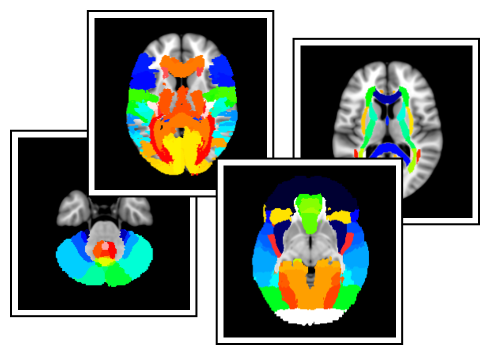
The fmrib Software Library (fsl) provides a tool to query whether regions belong or not to one of various atlases available. This well-known tool is called atlasquery, and it requires one region per image per run. To run for multiple separate regions on a single image image (e.g., a thresholded statistical map), a separate call to fsl‘s cluster command (not to be confused with the homonym cluster command that is part of the GraphViz package) is needed.
In order to automate this task, a small script called autoaq is available (UPDATE: the script is no longer supplied here; it has been incorporated into fsl). Usage information is provided by calling the command without arguments. This is the same script we posted recently to the fsl mailing list (here). Obviously, it does not run in Microsoft Windows. To use it, you need any recent Linux or Mac computer with fsl installed.
An example call is shown below:
./autoaq -i pvals.nii.gz -t 0.95 -o report.txt -a "JHU White-Matter Tractography Atlas"
The command will write temporary files to the directory from where it is called, hence it needs to be called from a directory to which the user has writing permissions. The atlas name can be any of the atlases available in fsl, currently being the ones listed below (note the quotes, ” “, that need to be provided when calling autoaq):
- “Cerebellar Atlas in MNI152 space after normalization with FLIRT”
- “Cerebellar Atlas in MNI152 space after normalization with FNIRT”
- “Harvard-Oxford Cortical Structural Atlas”
- “Harvard-Oxford Subcortical Structural Atlas”
- “JHU ICBM-DTI-81 White-Matter Labels”
- “JHU White-Matter Tractography Atlas”
- “Juelich Histological Atlas”
- “MNI Structural Atlas”
- “Oxford Thalamic Connectivity Probability Atlas”
- “Oxford-Imanova Striatal Connectivity Atlas 3 sub-regions”
- “Oxford-Imanova Striatal Connectivity Atlas 7 sub-regions”
- “Oxford-Imanova Striatal Structural Atlas”
- “Talairach Daemon Labels”
The list can always be obtained through atlasquery --dumpatlases. Information about these atlases is available here.
The output is divided in three sections. In the first, a table containing the cluster indices, size and coordinates of the peaks and centres of mass is provided. In the second part, the structures to which the cluster peaks belong are presented, along with the associated probabilities. In the third part, probabilities for each cluster as a whole is presented. If the atlas is a binary label atlas, the number shown is in fact the overlap percentage between the cluster and the respective atlas label. If the atlas is probabilistic, the value is the mean probability in the overlapping region.
Version history:
- 03.Oct.2012: Update – Fixed issue with the
md5command under a different name in vanilla Mac. - 25.Jan.2014: Update – Added options
-u(to update/append a previous report) and-pto show peak coordinates instead of center of mass. - 10.Dec.2014: The
autoaqhas been integrated into the freely available fmrib Software Library (fsl) and is no longer provided here. Hope you enjoy using it directly into fsl! :-)
